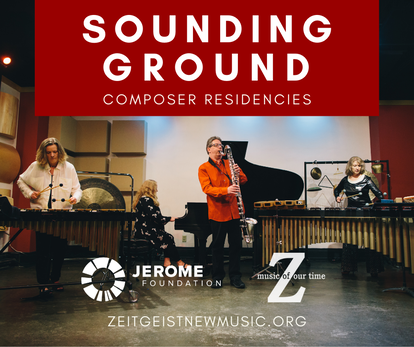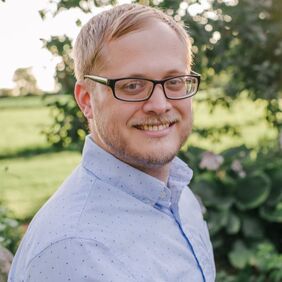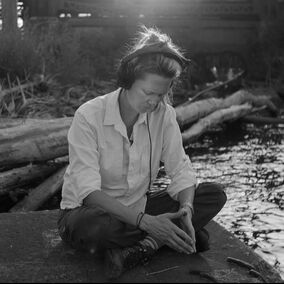Sounding Ground Showcase
|
February 16-17, 7:00 p.m.
Studio Z: 275 East 4th Street, St. Paul $20 / $15 students & seniors |
|

Join Zeitgeist and Sounding Ground artists Soomin Kim, Jonathan Posthuma, Jarrelle Barton, and Sara Pajunen for a performance of the new works they have developed through Sounding Ground. New works will include i grew up on a farm by Posthuma, Portage by Pajunen, Empty by Barton, and Treasure Hunt by Kim.
The SOUNDING GROUND composer residency program provides commissioning, development, and production support for Minnesota composers in the early stages of their careers. SOUNDING GROUND awardees work closely with Zeitgeist over an extended period on the development and production of a significant new work created for Zeitgeist.
The SOUNDING GROUND composer residency program provides commissioning, development, and production support for Minnesota composers in the early stages of their careers. SOUNDING GROUND awardees work closely with Zeitgeist over an extended period on the development and production of a significant new work created for Zeitgeist.

Guzheng musician Jarrelle Barton, began learning Guzheng with Minnesota expert Li Jiaxiang of Beijing when he was 14 years old. Relentlessly practicing, he began to improve his skill and started to compose his own music. Over a decade later Jarrelle is professionally performing in concerts, teaching students and arranging music for the Guzheng. With experience in teaching and concert level repertoire, he is constantly creating interesting new acoustic sound experiments and techniques on the Guzheng, as well as performing timeless traditional Guzheng classics.
Jarrelle Barton's work, fuses eastern and western sensibilities, musical concepts and improvisational spirit. The work is in several short movements, Emptiness, Solitude, and Promise, and also incorporates his signature work, The Dancing Phoenix.
Jarrelle Barton's work, fuses eastern and western sensibilities, musical concepts and improvisational spirit. The work is in several short movements, Emptiness, Solitude, and Promise, and also incorporates his signature work, The Dancing Phoenix.

Jonathan Posthuma (b. 1989) is a freelance composer and musician living in Saint Paul, Minnesota. His musical style seeks to combine lyricism, evocative imagery, and intense emotional contrasts while maintaining clarity in form and function at their deepest levels. He is often inspired by natural landscapes, gardening and visual art in his compositions and his largest project is Paul Klee : Painted Songs, an ongoing collection of chamber music inspired by the paintings of Paul Klee. He received his Masters in Music Composition from the University of Wisconsin – Madison, where he studied with Stephen Dembski and Laura Schwendinger and also studied composition with Luke Dahn at Dordt University. Jonathan is an active member of the Twin Cities choral community and has sung with VocalEssence Chorus, Kantorei, and impulse (MPLS) which have premiered several of his choral works in recent seasons. He also works as the Artistic Planning Manager for The Saint Paul Chamber Orchestra.
"I grew up on a farm, for Zeitgeist and fixed media, features a collection of field recordings I collected in 2013 from my childhood farm. These recordings represent an environment that no longer exists since my parents retired from hog farming shortly after they were made. As a first-generation college graduate from a rural Wisconsin community, my experiences growing up on a farm set me apart from many of my colleagues. This background is important to understanding who I am as a person and form my earliest sonic memories as a composer. Rural communities have changed dramatically in our nation with sharp contrasts between urban and rural life. As an artist with one foot in urban life and the other in my childhood memories on the farm, I feel torn between two worlds, often feeling like I don't belong in either."
"I grew up on a farm, for Zeitgeist and fixed media, features a collection of field recordings I collected in 2013 from my childhood farm. These recordings represent an environment that no longer exists since my parents retired from hog farming shortly after they were made. As a first-generation college graduate from a rural Wisconsin community, my experiences growing up on a farm set me apart from many of my colleagues. This background is important to understanding who I am as a person and form my earliest sonic memories as a composer. Rural communities have changed dramatically in our nation with sharp contrasts between urban and rural life. As an artist with one foot in urban life and the other in my childhood memories on the farm, I feel torn between two worlds, often feeling like I don't belong in either."

Sara Pajunen is a composer-improviser and an audiovisual artist based in what is now called Minnesota (USA). Trained as a violinist and employing locally-responsive media ranging from field recordings to drone imagery, her work is motivated by interactions between her ancestral roots, American cultural histories, and connection to our environments through sound.
Pajunen has released six albums using folk and traditional music as the basis for singular collaborations. In longterm multimedia projects "Mine Songs: Sounding an Altered Landscape" and "The Places We Know,” Pajunen uses environmental recording, violin and hardanger d’amore, archival material, and image to create new lenses that ask for reflection on the stories we tell ourselves (or have been told) about history, power, identity, and agency.
Pajunen has performed extensively in North America and Europe and her work has received funding from the Jerome Foundation, Minnesota State Arts Board, Kone Foundation, New Music USA, American Scandinavian Foundation, and the Arts Council of Finland, amongst others. She holds classical music degrees in both the United States and Finland and a Master of Music in Contemporary Improvisation from New England Conservatory, and her installation work has been exhibited in galleries throughout the Midwest.
Pajunen's “Portage" (from "Mine Songs: Sounding an Altered Landscape) employs sounds from the end of Minnesota Point (Neyaashi in Ojibwe) in Duluth, a long narrow sand spit that extends to a natural canal between Minnesota and Wisconsin. The short portage allowed Native people to pass between Gitchigami (Lake Superior) and Gichigami-ziibi (the outlet of the St. Louis River). After European settlement, shipping traffic increased with the building of the Salt Ste. Marie canal connecting Lake Superior to Lake Michigan and subsequently ignited competition between Minnesota and Wisconsin. Eventually the manmade canal now spanned by Duluth’s aerial lift bridge was dug, securing access for Minnesota and decreasing traffic through the natural canal. Listening and responding to this former place of portage reminds us how our landscapes have been forcibly manipulated by competition for resources on a scale made possible only by industrialization. How have we absorbed these values into our current relationship with the natural environment that surrounds us?
Pajunen has released six albums using folk and traditional music as the basis for singular collaborations. In longterm multimedia projects "Mine Songs: Sounding an Altered Landscape" and "The Places We Know,” Pajunen uses environmental recording, violin and hardanger d’amore, archival material, and image to create new lenses that ask for reflection on the stories we tell ourselves (or have been told) about history, power, identity, and agency.
Pajunen has performed extensively in North America and Europe and her work has received funding from the Jerome Foundation, Minnesota State Arts Board, Kone Foundation, New Music USA, American Scandinavian Foundation, and the Arts Council of Finland, amongst others. She holds classical music degrees in both the United States and Finland and a Master of Music in Contemporary Improvisation from New England Conservatory, and her installation work has been exhibited in galleries throughout the Midwest.
Pajunen's “Portage" (from "Mine Songs: Sounding an Altered Landscape) employs sounds from the end of Minnesota Point (Neyaashi in Ojibwe) in Duluth, a long narrow sand spit that extends to a natural canal between Minnesota and Wisconsin. The short portage allowed Native people to pass between Gitchigami (Lake Superior) and Gichigami-ziibi (the outlet of the St. Louis River). After European settlement, shipping traffic increased with the building of the Salt Ste. Marie canal connecting Lake Superior to Lake Michigan and subsequently ignited competition between Minnesota and Wisconsin. Eventually the manmade canal now spanned by Duluth’s aerial lift bridge was dug, securing access for Minnesota and decreasing traffic through the natural canal. Listening and responding to this former place of portage reminds us how our landscapes have been forcibly manipulated by competition for resources on a scale made possible only by industrialization. How have we absorbed these values into our current relationship with the natural environment that surrounds us?

Composer and vocalist Soomin Kim is a three-time winner of the ASCAP Foundation Morton Gould Young Composer Awards. In 2022, her orchestration of Helen Hagan’s Piano Concerto in C minor was premiered by pianist and musicologist Samantha Ege and the Yale Philharmonia under direction of Peter Oundjian. In 2018, she was selected to write for the Cleveland Chamber Symphony as part of their Young & Emerging Composers Project. She was also the composer-in-residence with the Northern Ohio Youth Orchestra during their 2017-18 concert season. Her work has been featured by the Sydney Festival, Liquid Music, and Aspen Music Festival among many, and she has collaborated with renowned ensembles and artists such as Ji Su Jung, JIJI, Ariana Kim, and Zeitgeist. Based in Minneapolis, MN, Soomin is currently on the faculty of The Saint Paul Conservatory of Music.
treasure hunt is a multi-movement work written for Zeitgeist plus two. In this work, I explore the literal and metaphorical treasures I have collected over the years. While the entire work is about 45-minute long, only five movements will be presented at this concert.
I’ve had an obsession with pearls for a while. According to the Natural History Museum, “pearls are made by marine oysters and freshwater mussels as a natural defense against an irritant such as a parasite entering their shell or damage to their fragile body.” It is a manifestation of the oysters and mussels processing physical trauma; quite literally an act of turning a lemon into a lemonade. This has made me think of my life as a journey of collecting pearls. Whenever I come across an obstacle or a lesson, I process it and turn it into an iridescent gem. In that way, living life is hunting for treasures.
treasure hunt is a multi-movement work written for Zeitgeist plus two. In this work, I explore the literal and metaphorical treasures I have collected over the years. While the entire work is about 45-minute long, only five movements will be presented at this concert.
I’ve had an obsession with pearls for a while. According to the Natural History Museum, “pearls are made by marine oysters and freshwater mussels as a natural defense against an irritant such as a parasite entering their shell or damage to their fragile body.” It is a manifestation of the oysters and mussels processing physical trauma; quite literally an act of turning a lemon into a lemonade. This has made me think of my life as a journey of collecting pearls. Whenever I come across an obstacle or a lesson, I process it and turn it into an iridescent gem. In that way, living life is hunting for treasures.


